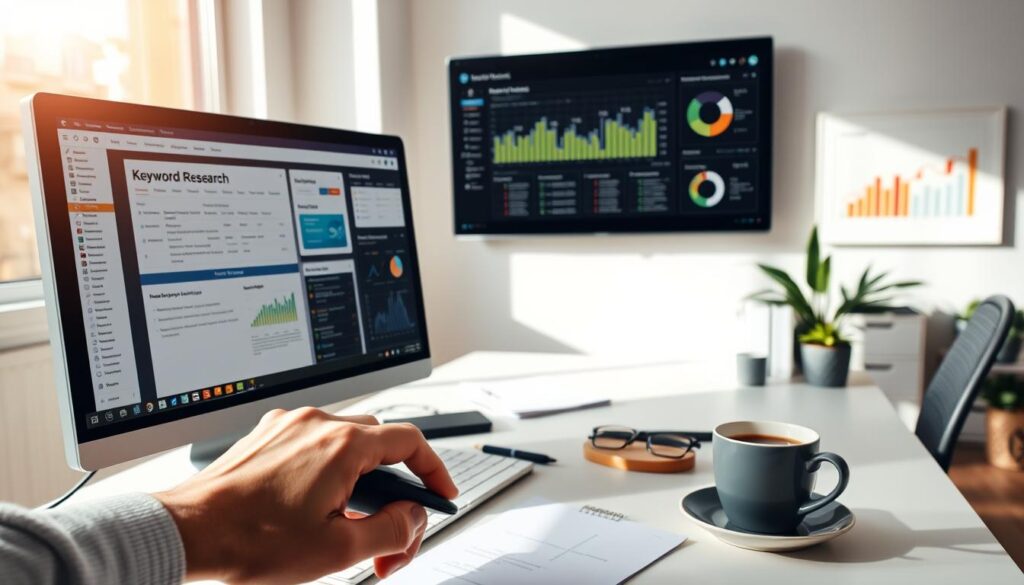Imagine your website as a library. Without proper organization, even the best books get lost. That’s where search engine optimization comes in. It helps platforms like Google find, understand, and rank your content so users discover it effortlessly.
For newcomers, learning the basics of engine optimization might feel overwhelming. But breaking it down simplifies everything. Think of it as a roadmap: clear structure, smart keyword choices, and aligning with what search engines value most. This guide will walk you through each phase without jargon.
A well-organized site acts like a welcome sign for crawlers. Clean navigation and fast loading times matter. Pair this with keyword research to identify terms your audience actually uses. Together, these steps build visibility and trust with both users and algorithms.
By the end of this article, you’ll grasp how search engine optimization drives organic traffic. We’ll cover technical tweaks, content strategies, and why consistency matters. Let’s dive in!
Key Takeaways
- SEO helps search engines find and prioritize your content.
- Beginners benefit from focusing on website structure and user-friendly design.
- Keyword research identifies terms your audience uses to search.
- Technical elements like site speed impact search rankings.
- Consistent optimization improves long-term visibility.
Introduction to SEO and Its Importance
Picture a bustling digital marketplace where millions compete for attention. Without a clear roadmap, even valuable content gets buried. This is where search engine optimization becomes your compass—guiding both visitors and algorithms to your virtual doorstep.
Defining SEO and Its Role
Search engine optimization acts as a bridge between your content and people searching for solutions. It’s not just about ranking higher. It’s about making your website understandable to crawlers while delivering value to real users. Google’s automated bots scan pages daily, prioritizing sites that follow their Search Essentials guidelines.
Why SEO Matters for Your Website
Think of SEO as a double win. Improved user experience keeps visitors engaged longer—lowering bounce rates and signaling quality to search engines. A well-optimized site loads quickly, uses clear headings, and answers questions directly. As one Google engineer noted:
“The best optimization happens when humans and algorithms both feel respected.”
Businesses investing in SEO see 55% more organic traffic on average compared to non-optimized sites. It’s not magic—it’s about aligning your content with what search systems reward. From mobile-friendly designs to intuitive navigation, every tweak builds credibility. Start smart, and watch your digital presence grow.
How Search Engines Work: Crawling, Indexing, and Ranking
Behind every Google search lies a complex system working 24/7. Search engines use automated bots, called crawlers, to explore the web. These bots follow links between pages, much like a librarian organizing books. Their goal? To build a massive catalog of online content.

Understanding Crawlers and Indexes
Crawlers start with known pages and branch out through internal links. For example, Googlebot might begin at your homepage and navigate to blog posts via your menu. Websites using XML sitemaps make this process smoother, guiding bots to important pages. Discovered content then lands in an index—a searchable database tagged with relevant keywords.
How Rankings Are Determined
Once indexed, pages compete for visibility. Algorithms evaluate hundreds of factors, including:
| Factor | Impact Level | Example |
|---|---|---|
| Content Relevance | High | Matching user search terms |
| Backlink Quality | Critical | Links from trusted news sites |
| Page Speed | Moderate | Loading under 2 seconds |
High-quality links act like votes of confidence. Pages answering questions clearly and quickly often rise to the top. Regular updates also signal freshness, keeping your content competitive in search results.
Understanding How SEO Works Step by Step
Effective optimization unfolds in stages, much like planting a garden that blooms over seasons. Each phase builds on the last, creating a sustainable path to visibility. Let’s explore the roadmap that turns effort into measurable results.
Breaking Down Each SEO Stage
First, technical health forms the foundation. Ensure fast loading speeds and mobile-friendly designs. Sites with clean code and secure connections rank higher.
Next, prioritize user intent through keyword research. Tools like Google Trends reveal what terms people actually search. Align your content with these phrases naturally—no stuffing.
Then, focus on link building. Quality backlinks from trusted sources act like digital endorsements. A local bakery, for example, gained traction by earning mentions from food bloggers and regional directories.
Real-World Examples of SEO in Action
Consider a tech blog that doubled traffic in six months. They optimized existing posts with target words in headers and image descriptions. Internal links guided readers to related guides, boosting time spent on-site.
Another case: An e-commerce store improved rankings by fixing broken links and compressing images. Within three months, organic visits rose 40%. Changes take time, but consistency pays.
Remember, every tweak serves two masters: algorithms and real people. Structure content for clarity, use descriptive anchor text, and update regularly. This balanced way keeps both search engines and visitors engaged.
Conducting Effective Keyword Research
Successful online visibility starts with understanding what your audience searches for. Keywords act as signposts, guiding users to your content. But not all terms hold equal value—strategic research ensures you prioritize phrases that align with real queries and business objectives.

Tools and Techniques for Keyword Discovery
Begin with free methods like Google Suggest. Start typing a word into the search bar, and it reveals popular long-tail variations. For example, searching “best running shoes” might prompt suggestions like “best running shoes for flat feet” or “best trail running shoes.” These insights come directly from actual user behavior.
Advanced tools like Semrush or Ubersuggest take this further. They provide data on search volume, competition levels, and related terms. A bakery might discover “gluten-free birthday cakes near me” has high local demand but low competition—a golden opportunity.
Matching Keywords to User Needs
Once you gather terms, focus on relevance. A pet store could target “durable dog toys for heavy chewers” instead of generic “dog toys.” Specific phrases attract visitors ready to engage or buy.
Integrate these keywords naturally into headers, meta descriptions, and image alt text. This optimization strengthens on-page SEO, signaling to search engines that your content answers real questions. As one marketer noted:
“Keywords are bridges—they connect problems to solutions.”
Regularly update your list based on trends and performance metrics. Tools like Google Analytics show which terms drive traffic, letting you refine strategies over time.
Optimizing On-Page SEO Elements
Think of your page’s metadata as a digital handshake. It introduces your content to both users and search engines before they visit. Clear titles and descriptions act like friendly invitations—they set expectations and drive clicks.
Crafting Title Tags and Meta Descriptions
Title tags are your first chance to impress. Keep them under 60 characters and front-load key terms. A bakery might use: “Artisan Sourdough Bread | Fresh Daily | Brooklyn Bakery” instead of generic “Bread Shop.”
Meta descriptions should tease value in 155 characters. Google often uses this text in search snippets. Include action verbs: “Discover 5 proven techniques for flakier croissants” outperforms vague statements.
Structuring Content with Headers and Keywords
Break text into scannable sections using H2/H3 headers. A guide about ranking factors might organize topics like:
- Technical site health
- Content depth
- User engagement signals
Place keywords naturally in headers and opening paragraphs. But avoid stuffing—Google’s John Mueller notes:
“Write for people first, algorithms second.”
Well-structured web pages perform 73% better in rankings. Use bullet points for lists and bold text for key terms. This format helps readers absorb information quickly while signaling relevance to crawlers.
Boosting Technical SEO for Better Visibility
Think of technical SEO as the invisible framework holding your website together. While keywords and content attract visitors, factors like loading times and mobile adaptability determine if they stay. Google prioritizes sites offering seamless experiences across devices—slow pages or clunky designs push users away.

Improving Site Speed and Mobile Friendliness
Pages loading in under two seconds rank higher on average. Tools like Google PageSpeed Insights identify bottlenecks: uncompressed images, bulky code, or slow hosting. Mobile-first indexing means your site must:
- Adjust layouts for smaller screens
- Use tap-friendly buttons
- Avoid intrusive pop-ups
Case in point: An outdoor gear retailer reduced load time by 1.5 seconds through image compression. Mobile traffic jumped 28% within eight weeks.
Enhancing Site Structure and URL Optimization
Clean URLs act like street signs for crawlers. Compare these examples:
| Poor Structure | Optimized Version |
|---|---|
| example.com/?p=123 | example.com/hiking-boots |
| example.com/blog/post7 | example.com/guides/camping-tents |
Use hyphens between words and keep hierarchies shallow. Internal links should guide visitors naturally—like connecting a “Winter Jackets” page to “Cold-Weather Accessories.”
Regular audits catch broken links, duplicate content, and crawl errors. As one developer notes:
“Technical health isn’t glamorous, but it’s the bedrock of sustainable growth.”
Investing in these foundations pays off: Sites with strong technical setups see 3x more organic traffic over two years compared to competitors cutting corners.
Building Quality Backlinks and Off-Page SEO
Imagine your website as a trusted expert in a crowded room. Backlinks act like nods of approval from peers, signaling credibility to search engines. Earning these connections requires strategy, not luck.
Smart Ways to Earn Links
Broken link building works like digital karma. Find outdated links on reputable sites, then offer your content as a replacement. A travel blog gained 15 high-authority links this way by fixing broken resource pages on tourism boards.
Outreach remains powerful. Partner with audience-focused platforms for guest posts or interviews. A local bakery featured in a regional food magazine saw referral traffic triple—and those links boosted their local search rankings.
Learning From Competitors
Tools like Ahrefs reveal where rivals get their backlinks. One SaaS company discovered competitors earned links from tech podcasts. They launched their own interview series, earning 40+ links in six months.
| Strategy | Effort Level | Average Links Earned |
|---|---|---|
| Resource Page Outreach | Medium | 8-12/month |
| Guest Posting | High | 4-6/month |
| Digital PR Campaigns | Very High | 15-20/month |
As one marketer shared:
“Links should feel earned, not bought. Focus on relationships, not transactions.”
Start small. Audit existing content for link-worthy assets like original research or tools. Then, contact sites that align with your guide to valuable resources. Consistent effort builds momentum—and search visibility.
Enhancing User Experience Through Content Design
Great content feels like a conversation, not a lecture. When you prioritize clarity and engagement, both people and search engines take notice. Clean layouts and scannable text keep visitors glued to your page—and algorithms reward that behavior.
Designing for Humans and Algorithms
Start with typography. Fonts like Arial or Open Sans improve readability on screens. Proper spacing between lines and paragraphs reduces eye strain. These tweaks help google search crawlers identify well-structured content, boosting your rankings.
Visual hierarchy matters too. Use contrasting colors for headers and buttons. A study found pages with clear CTAs increased conversions by 27%. As one UX designer put it:
“Every pixel should guide users toward their goal.”
For business growth, integrate interactive elements. Quizzes or calculators encourage participation. Videos explaining complex topics can cut bounce rates by 34%. Always add transcripts—they’re goldmines for keyword placement.
Remember, your content serves real people. Break up text with bullet points or numbered lists. Tools like Hemingway Editor highlight dense sentences. Pages scoring Grade 8 readability see 42% longer visit times on average.
Optimizing for google search doesn’t mean sacrificing creativity. Balance multimedia with white space. Test different layouts using heatmaps. When users stay engaged, search engines interpret it as quality—a win-win for visibility and value.
Leveraging Multimedia and Visual Elements
Visual content isn’t just decoration—it’s a strategic asset in modern digital storytelling. When paired with smart optimization, images and videos amplify your page’s appeal to both users and search engines. Let’s explore how to transform visuals into traffic magnets.
Alt Text: The Secret Sauce for Images
Descriptive alt text acts as a translator for engines. Instead of generic labels like “product photo,” use specifics: “handcrafted leather wallet with RFID protection.” This helps crawlers index visuals accurately while improving accessibility.
For example, a bakery saw a 22% traffic increase after updating image descriptions with local keywords like “organic sourdough bread Boston.” Detailed captions also matter—they provide context for complex infographics or charts.
Videos That Keep Visitors Glued
Embedding tutorials or testimonials can boost time-on-page by 40% on average. Host videos on platforms like YouTube, then embed them with optimized titles and transcripts. This dual approach caters to industry trends while feeding search algorithms relevant text.
| Media Type | Optimization Tip | Traffic Impact |
|---|---|---|
| Product Images | Use alt text with color/size details | +18% clicks |
| Explainer Videos | Add chapters for easy navigation | +35% watch time |
| Infographics | Include data sources in captions | +27% shares |
One marketing director shared:
“Treat visuals like puzzle pieces—each should fit your content’s narrative while carrying hidden SEO value.”
Align media with your audience’s needs. Tech blogs thrive on screenshots with annotated steps, while travel sites benefit from immersive 360-degree photos. Test formats regularly to match shifting industry preferences.
Measuring SEO Success and Refining Your Approach
Think of SEO as a dynamic sport—stats tell you whether your training pays off. Tracking the right metrics reveals what’s working and where to pivot. Without data, you’re navigating blindfolded.
Key Metrics to Track for SEO Performance
Organic rankings show where your pages land for target terms. But don’t stop there. Click-through rates (CTR) measure how enticing your snippets are. A 5% CTR might seem okay until you learn competitors hit 8% for similar terms.
Conversion rates tie efforts to business goals. If a blog drives 1,000 monthly visitors but zero email signups, something’s off. Tools like Google Search Console and Ahrefs offer granular results—track weekly.
Iterating Strategies Based on Data Insights
Users leave digital breadcrumbs. High bounce rates on a product page? Maybe the content doesn’t match search intent. Heatmaps showing ignored CTAs? Redesign for clarity.
Combine quantitative information with qualitative feedback. Customer surveys might reveal confusing navigation—a fix that boosts time-on-site by 20%.
| Data Source | Insight | Action |
|---|---|---|
| Analytics | Mobile traffic converts 30% less | Optimize checkout for smaller screens |
| Session Recordings | Visitors abandon cart at step 3 | Simplify form fields |
As one marketing director shared:
“Data doesn’t lie. Let it guide your A/B tests and content updates.”
Monthly reviews keep strategies fresh. Adjust keyword targets, prune underperforming pages, and double down on winners. This cycle turns results into lasting growth.
Conclusion
Mastering search visibility is a journey, not a sprint. From technical foundations to content polish, each layer builds momentum. Clean pages with logical url structures act as welcome mats for crawlers, while targeted keywords connect your work to real-world queries.
Consider a local bookstore that climbed search rankings. They optimized product pages with reader-focused terms, improved site speed, and earned backlinks through community partnerships. This example shows how integrated strategies create lasting results.
Algorithms change, but core principles endure. Regular updates, audience-focused content, and technical health remain non-negotiables. Track progress, adapt to trends, and celebrate small wins.
Remember, every tweak matters. Start with one improvement—whether compressing images or refining meta tags—and build from there. With patience and smart adjustments, your digital presence will thrive.
